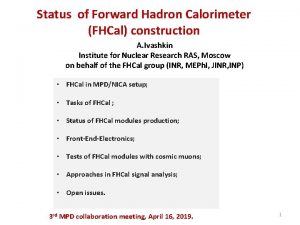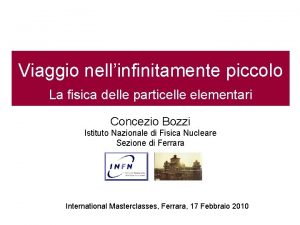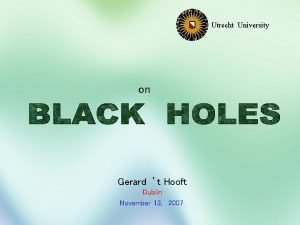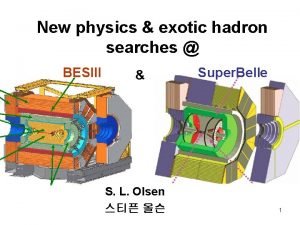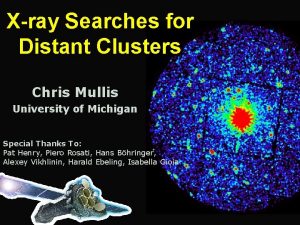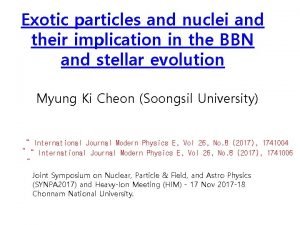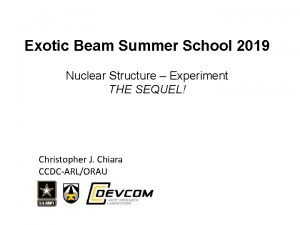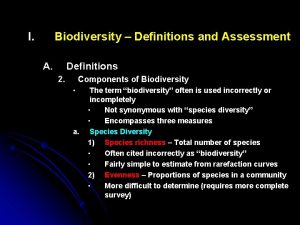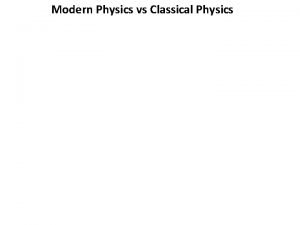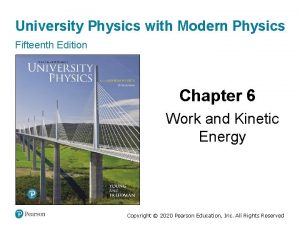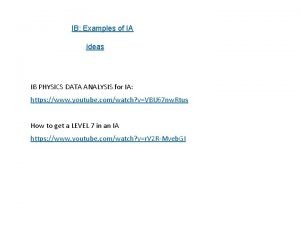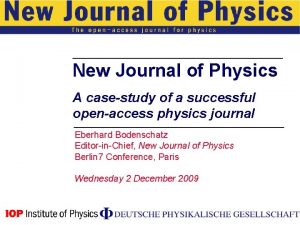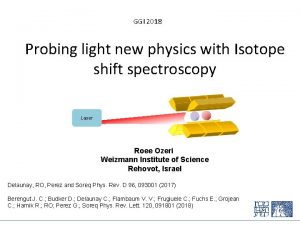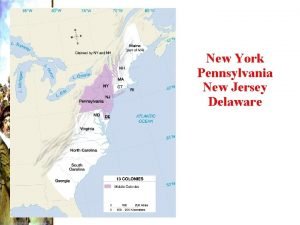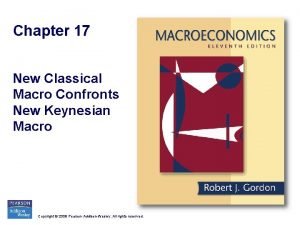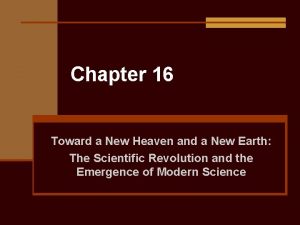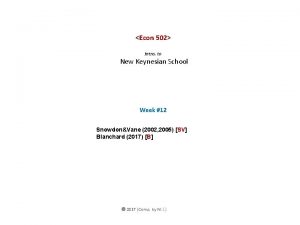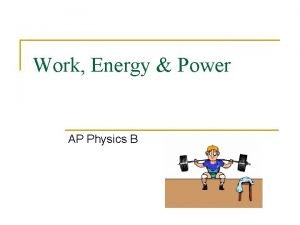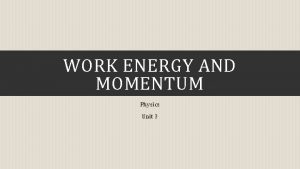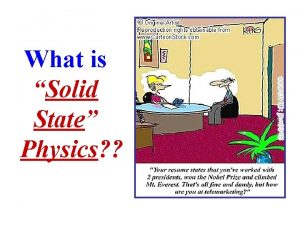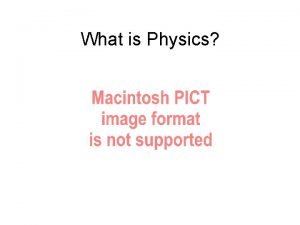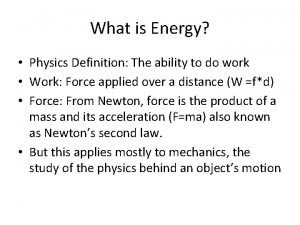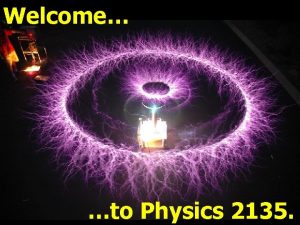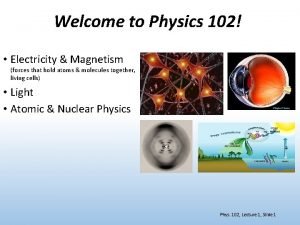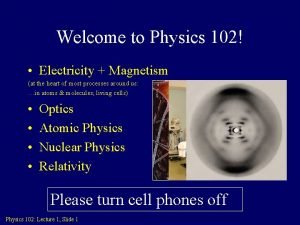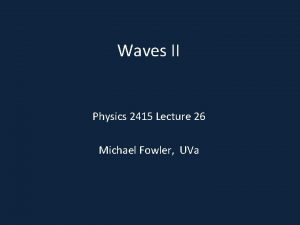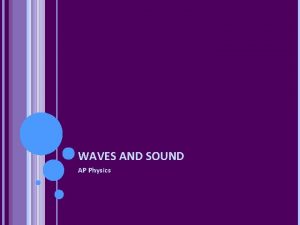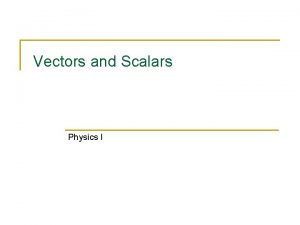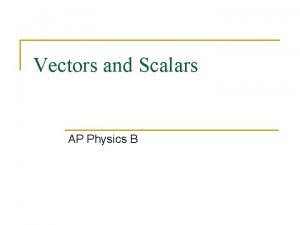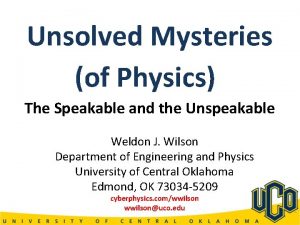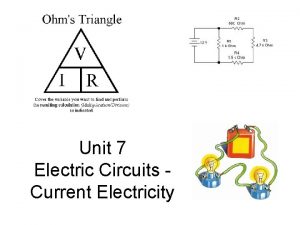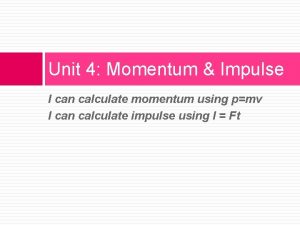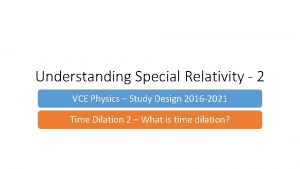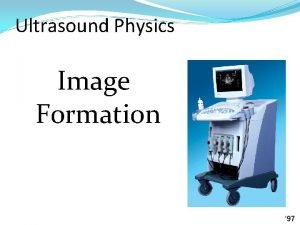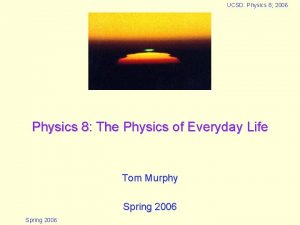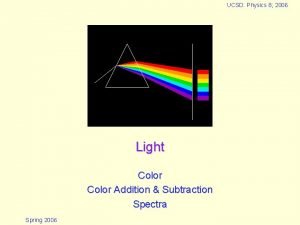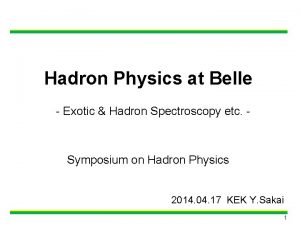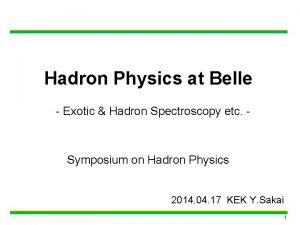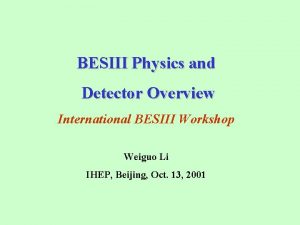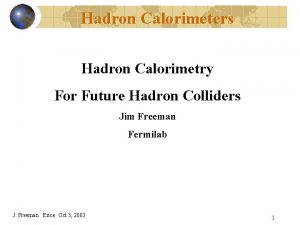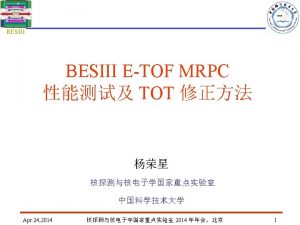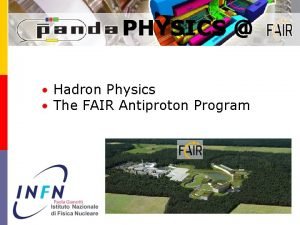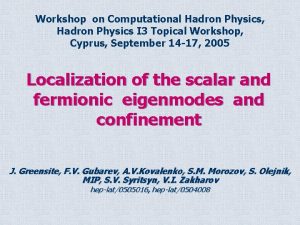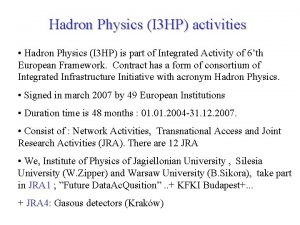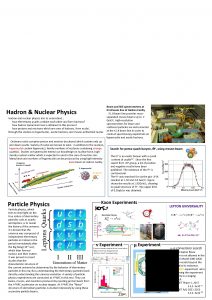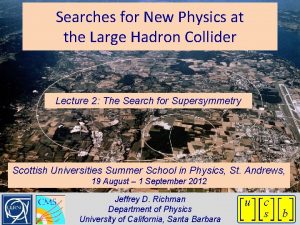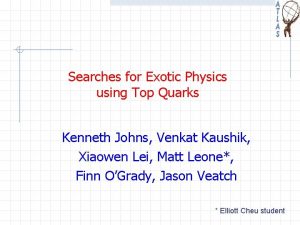New physics exotic hadron searches BESIII S L

New physics & exotic hadron searches @ BESIII & S. L. Olsen 스티픈 올슨 Super. Belle 1

BEPCII & Super. KEKB ARES RF(LER) ARES RF(HER) L=2 x 1035 cm-2 s-1 (2012) 8 x 1035 cm-2 s-1 (2017) 2

Super. KEKB & BEPCII each provide 10 x luminosity increases over the current state-of-the-art Super KEKB BEPCII CLEO-c 2010 3

BESIII & Super Belle § 1 T SC solenoid: sp/p ~ 0. 5% @ p~1 Ge. V §Si strip/pixel vertex detector sz~70 mm § /K separation up to 1. 2 Ge. V § 1. 5 T SC solenoid: sp/p ~ 0. 3% @ p~1 Ge. V §Cs. I (~90% x 4 ) sm( 0 gg) ~4 Me. V § /K separation up to ~4 Ge. V §Muon detection ~80% x 4 pm>0. 5 Ge. V §Cs. I (~90% x 4 ) sm( 0 gg) ~4 Me. V §Muon detection ~80% x 4 pm>0. 5 Ge. V Both are modern, state-of-the-art detectors 4

Physics at BESIII & Super. Belle • New physics searches – Tests of SM predictions for processes with heavy +Winos? virtual particles +Squarks? H+ ? – Search for decays that are forbidden in SM • t mg • J/y m+e • … • Exotic hadron physics – XYZ particles u c tetraquarks? c u quark-gluon hybrids? c c 5

New Physics Searches • Need SM processes that: – involve massive virtual particles – where SM prediction is precise and reliable • • • CP-violating phases F-B asymmetry in B K*l+l 0 - meson: P+ l+n decays CP violation in the c-quark sector … 6

CP-violating phases (SM predictions for CPV phases are uneffected by QCD Corrections & are, in principle at least, robust. ) 7

SM: CP violation phase is all in the CKM flavor-mixing matrix CPV phases are in the corners 1 Vtd t 3 * Vub b u W+ d W+ 8

1: Interfere B f. CP with B B J/y. KS Vcb has no KM phase Vcb J/ B 0 Vtd KS + has a KM phase 1 V*td B 0 Vtb Vcb V*td 2 J/ sin 2 1 B 0 Vtb td V*td KS 9

“principle” of 1 measurement Flavor-tag decay (B 0 or B 0 ? ) e J/ _ “entangled” BB e t=0 sin 2 1 z KS more B tags This is for CP=-1; for CP=+1, the asymmetry is opposite 10

B-Factory results 0 _B tag B 0 tag sin 2 1= 0. 671 ± 0. 024 Belle + Ba. Bar (2008) 1 = 21. 1 o ± 0. 9 o well measured! 11

Role of phases in the CKM flavor-mixing matrix was recognized by the Nobel Foundation A single irreducible phase in the weak interaction matrix can accounts for the CPViolations that are observed in kaon and B decays. 12

Peggy Lee (American singer 1920 -2002) 13

Next: CPV in penguin decays , h’, K+K-, … 14

Why penguins? 15

Not all penguins are alike! New physics penguins can modify SM predictions SM Charged Higgs 16 Super. Symmetry 16

sin 2 1 with SM b s penguins Vts: no KM phase * Vtd , ’, K K- + B B Vtd* 1 , ’, K K- 1 SM: sin 2 1 = sin 2 1 from B J/y K 0 penguin Any difference non-SM particles in the loop 17

Dalitz plot analysis of B KSK+Ktime-dependent! Strong K+K- peak in M(K+K-) dist but that is not all M 2 (K+KS) M 2 (K-KS) B 0 Needs a model for B 0 KSK+K- decays & a full. t-dependent Dalitz analysis 18

( KS) 1 SM result (f 0(980) KS) 1 Room for ~10 x improvement Super Belle/KEKB 19

Electro-weak penguins: B—K* l+lno gluons here (so SM predictions for the lepton sector are robust & reliable) B K* 20

AFB(B K*l+l-)(q 2) F B NF-NB NF+NB = Ali, Mannel, Morozumi, PLB 273, 505 (1991) SM pred’n for AFB is not sensitive to (poorly known) QCD corrections 21

Hints of an anomaly? 657 M e Bell ary imin l e r P BABAR, ar. Xiv: 0804. 4412 384 M Belle, PRL 96, 251801 386 M • Data points are all above the SM • (Ml+l-2 dist & branching fractions ~agree with SM expectations. ) e Bell ed lish b u P 22

0 - meson pure leptonic decays: P + l+ n Q + B+ (or D+ or Ds) q SM prediction (W+ only): All inputs well measured except f. P , which can be computed by LQCD 23 23

Latest B-factory result (ar. Xiv: 0809. 3834, BELLE-CONF-0840) Semileptonic B tags only (B D*l ) Pre lim ina ry SM: (CKMfitter 2008 prediction) 3. 8σ signal significance Measurement above SM expectation, discrepancy ~1. 4 -2σ 24

Belle limits on charged Higgs Ruled out by Bf(B+ t+n) Ruled out (95% CL) by Bf(B Xsg) 25

(Almost) all of CMS’ accessible range for an MSSM H+ is already ruled out Region Left For LHC e ll e y. B b ut o led u R Accessible at LHC 26

D+(Ds+) l+n at BESIII CLEO-c signals: D+ m n LQCD preds (~2% precision) Ds+ t n 3 s SM-Expt discrepancy for f. Ds; statistical errors dominate Clean expt’l signals. BESIII can achieve high precision. 27

CPV in D meson decays at BESIII • No KM phases in c s or c d – Any CPV seen in D meson decay would indicate new physics No SM CPV phases here Opposite sign for matter-antimatter • To observe CP-viol. you need both a CPV phase & a non-zero strong phase – c. f. D± K+K- ± has lots of resonances with large strong phases Same sign for matter-antimatter 28

D ± K + K - ± model D± K*K’ KKp … “strong” phases 29

Fit for D+ D- differences CLEOc , with 818 pb-1 at the ’’ ar. Xiv 0807. 4545 M+ - M - ACP = (-0. 03 ± 0. 84 ± 0. 29)% BESIII will have >20 x more data 3030

Summary (New Physics) • Super Belle & BESIII have unique opportunities to search for New Physics – Reaches beyond the LHC for some scenarios • Room for a factor ~10 improvement in precision before SM limitations are reached. • Tantalizing hints of new phenomena show up in B-factory & CLEO-c data. • Dalitz analyses becoming increasingly important 31

Comment • New Physics Searches are prime motivators for Super-Belle & BESIII – “pays the bills” • New discoveries will “belong to” the host laboratories & the expt’l teams in entirety – SNU included • SNU group needs “signature” topics & expertise – Dalitz analyses? – exotic hadrons? – … 32

Exotic hadrons at BESIII & Super. Belle 33

Motivation for exotic hadrons Particle Physics Textbooks Perkin’s textbook, Introduction to High Energy Physics, pg. 118 “The states observed in nature consist of threequark combinations (the baryons) and quarkantiquark combinations (the mesons). ” But QCD suggests that tetraquarks and quark-gluon hybrids also occur. u c c 34

How to find an exotic hadron • Find a hadron with quantum numbers that can’t be produced by qqq or qq combos – Pentaquark: S=+1 baryon Q = s d u – Charged or strange “charmonium: ” _ e. g. Z+= u c c d _ • Find cc or bb mesons that don’t fit into an _ unassigned qq “quarkonium” level. 35

Only a few charmonium levels are still available Charmonium meson spectrum predicted measured 36 36

Neutral “X” & “Y” mesons X(3872) B K + -J/ ’ Belle Y(4260) JPC=1++ Ba. Bar e+e- g. ISR + -J/ 72) M( + -J/ )-M(J/ ) Y(3940) Belle Y(4008)? X(38 Belle (Decay to final states with a cc pair & Sqi=0 ) JPC=1 -- B K w. J/ Ba. Bar M( + -J/ ) B K w. J/ e+e- g. ISR + - ’ Y(4350) & Y(4660) Ba. Bar M(w. J/ ) Belle M(w. J/ ) X(3940) e+e- DD*J/ M( + - ’) X(4160) e+e- D*D*J/ Belle ? ? ? e+e- g. ISRLc. Lc Belle 37 M(DD*) M(D*D*) M(Lc. Lc) 37

No obvious available cc assignments for these states 3872 Me. V • Only one unfilled 1++ level • Mass is too low for the X(3872) • cc 1’ J/ violates Ispin • Bf(X 3872 J/ )>4% • G(g. J/ ) should be >>G(r. J/ ) • expt: G(g. J/ ) <<G(r. J/ ) cc 1’ • There is only 1 unfilled 1 -- charmonium level (& at least 3 1 -- Y states) • G( J/ ( ’)) for Y states too large for charmonium 38 38

Are there similar states with: • non-zero charge? • Z + • non-zero strangess? • Z s 0 • u • c • d • s • c • d • non-zero charge & strangeness? Zs + • u • c c s “smoking guns” for non qq meson states 39

The Z(4430)+( ± ’) meson candidate Veto M 2( ± ’) Ge. V 2 Z(4430) M( ± ’) Ge. V B K + ’ M 2(K ’) Ge. V 2 S. -K. Choi et al (Belle) PRl 100, 142001 40

Could this be a reflection from the K channel? 41

Cos q vs M 2( ’) q ’ K +1. 0 22 Ge. V 2 (4. 43)2 Ge. V 2 0. 25 cosq M 2( ’) 16 Ge. V 2 M ( ’) & cosq are tightly correlated; a peak in cosq peak in M( ’) -1. 0 42

Can interference between K partial waves produce a peak? Only S-, P- and D-waves seen in data interfere Add incoherently 43

Can we make a peak at cosq ≈0. 25 with only S-, P- & D-waves? 44

Can we make a peak at cosq ≈0. 25 with only S-, P- & D-waves? 45

Can we make a peak at cosq ≈0. 25 with only S-, P- & D-waves? Not without introducing other, even more dramatic features at other cosq (&, , other M ’) values. 46

Ba. Bar doesn’t see the Z(4430)+ M 2( ± ’) Ge. V 2 Belle: = (4. 1± 1. 0± 1. 4)x 10 -5 47

C. Hearty @ SLAC’s B-factory Symposium 48

B K ’ Dalitz-plot analyses Default Model B K* ’ k ’ K 2* ’ K*(890) ’ Kpy’ K*(1410) ’ K 0*(1430) ’ KZ+ K 2*(1430) ’ K*(1680) ’ KZ(4430) 49

Results 1 3 2 4 Toy MC: fit CL=36% 1 2 3 4 5 B A C B C 5 A 50

Results with no Z(4430) term 2 1 12 3 4 5 C B 3 4 A A B 5 Toy MC: fit CL=0. 1% C 51 51
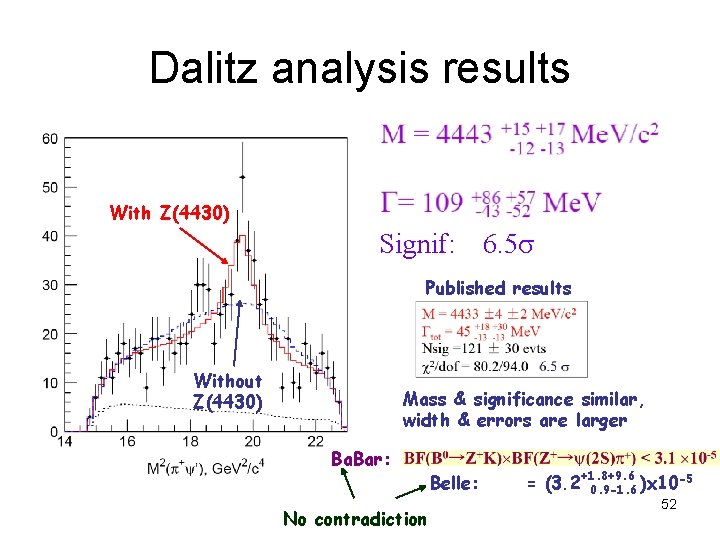
Dalitz analysis results With Z(4430) Signif: 6. 5 s Published results Without Z(4430) Mass & significance similar, width & errors are larger Ba. Bar: No contradiction Belle: -5 = (3. 2+1. 8+9. 6 0. 9 -1. 6 )x 10 52

Candidates for exotic mesons in the s-quark sector Accessible at BESIII 53
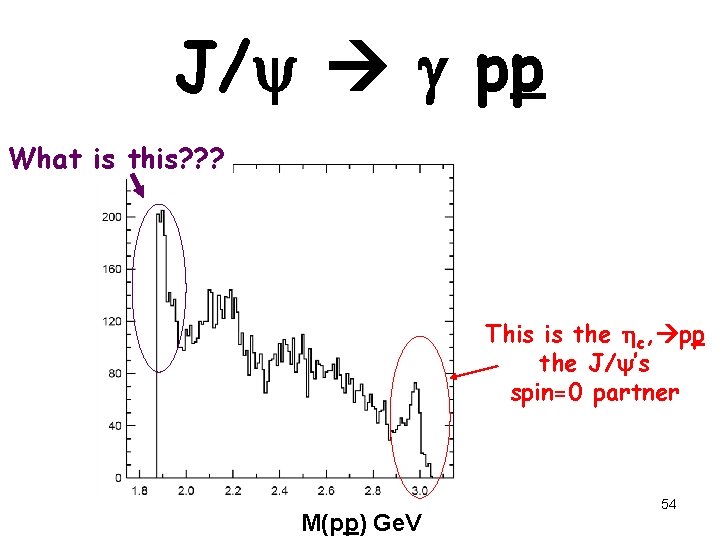
J/ g pp What is this? ? ? This is the c, pp the J/ ’s spin=0 partner M(pp) Ge. V 54
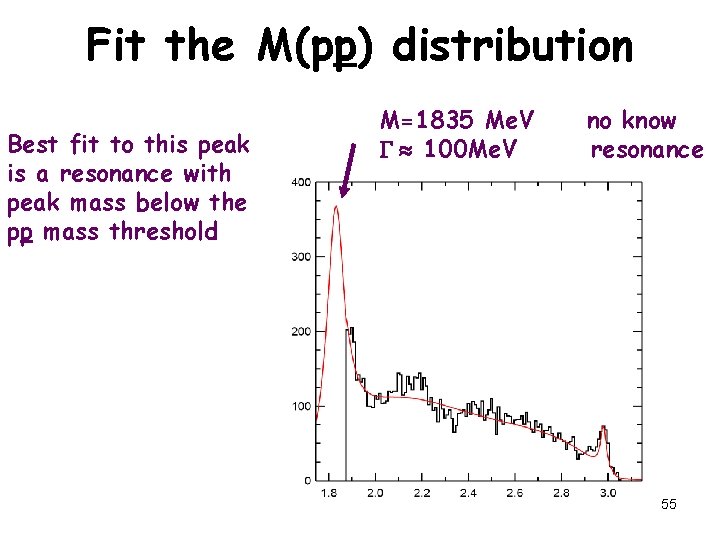
Fit the M(pp) distribution Best fit to this peak is a resonance with peak mass below the pp mass threshold M=1835 Me. V G 100 Me. V no know resonance 55
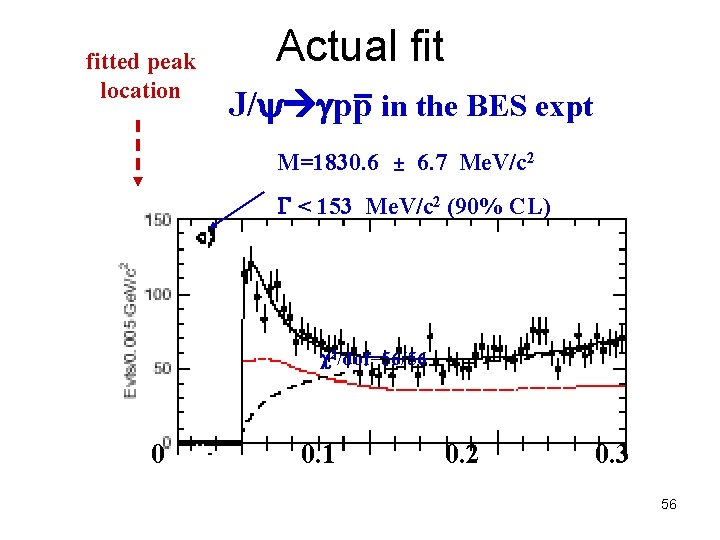
fitted peak location Actual fit J/ gpp in the BES expt M=1830. 6 ± 6. 7 Me. V/c 2 G < 153 Me. V/c 2 (90% CL) c 2/dof=56/56 0 0. 1 0. 2 0. 3 56

A pp bound state (baryonium)? There is lots & lots of literature about this possibility deuteron: baryonium: attractive nuclear force p n loosely bound 3 -q 3 -q color singlets with Md = 2 mp- e attractive force? p p loosely bound 3 -q color singlets with Mb = 2 mp-d ? 57

Expectation for pp bound state meson below-threshold p annihilate to mesons I=0, JPC=0 -+ init. state: pp - ’ is common (h’ = mostly ss) Above threshold X pp ~100% mp +mp 58
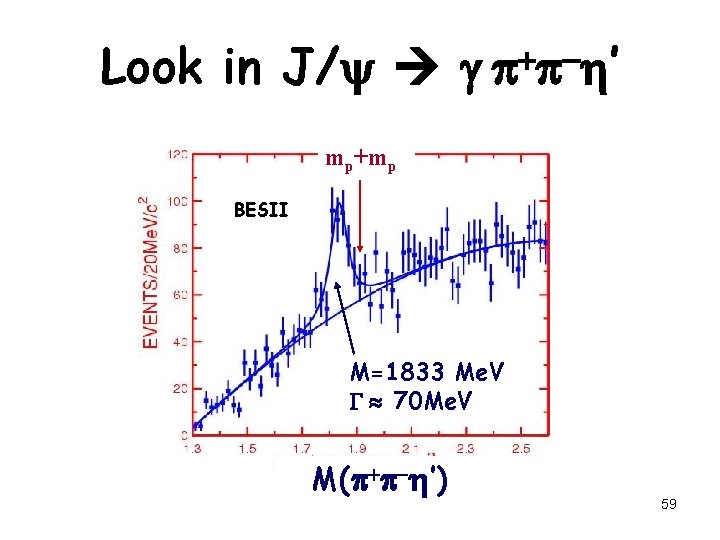
Look in J/ g - ’ mp+mp BESII M=1833 Me. V G 70 Me. V M( - ’) 59
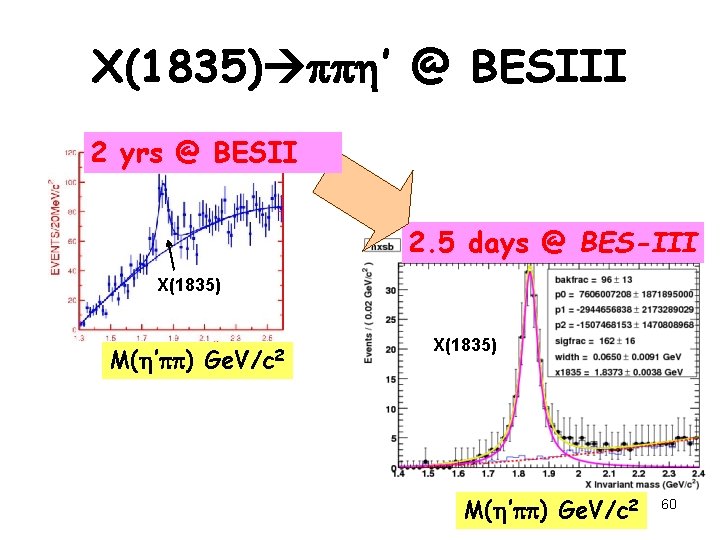
X(1835) ’ @ BESIII 2 yrs @ BESII 2. 5 days @ BES-III M( ’ ) Ge. V/c 2 X(1835) M( ’ ) Ge. V/c 2 60
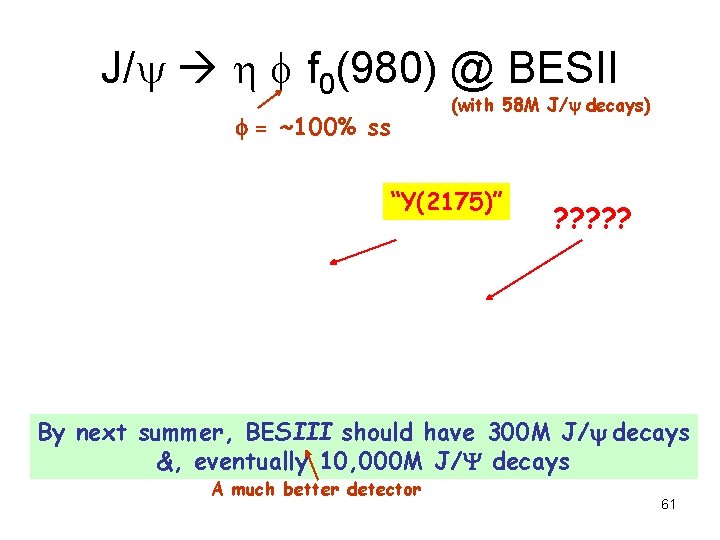
J/y h f f 0(980) @ BESII = ~100% ss (with 58 M J/ decays) “Y(2175)” ? ? ? By next summer, BESIII should have 300 M J/ decays &, eventually 10, 000 M J/Y decays A much better detector 61

Proposed WCU research @ BESIII & (Super)Belle • Continue collaboration with S. -K. Choi – Dalitz analyses of B light hadrons + (cc) with existing Belle data • Systematic scan of J/y h’X & f X @ BESIII – Search for s-quark sector exotics • New physics searches in D(Ds) decays@ BESIII – D+ / D- K+K-p± Dalitz plot differences – D+(Ds) l+n purely leptonic decays –… • Get ready for Super. Belle 62

- Slides: 63

